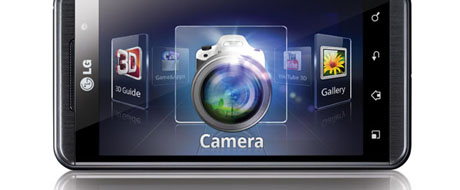Sprint launches HTC Evo 3D today, 3D smartphone showdown with AT&T's LG Thrill 4G imminent

It's not often that you get to compare two phones from two different carriers under the same roof, but I got to do just that at the CEA Line Shows Exhibit in New York City this week. With the national of the HTC Evo 3D on Sprint today, I thought I should give my initial impressions on the Evo 3D and the LG Thrill 4G (above, due in AT&T stores some time this summer), as both are 3D glasses-free, 3D smartphones.
On paper, the Evo 3D seems to be clear winner in the specs race with a dual-core 1.2 GHz Snapdragon processor, Adreno 22 GPU, 4.3" inch S-LCD screen at 540 x 960 pixels, 1 GHz of RAM, 4 GB of internal memory and will ship with Android Gingerbread and at newest version of the HTC Sense UI.
The Thrill 4G, on the other hand, will ship with Froyo albeit with a proprietary UI (as announced in AT&T's press release from June 22), is powered by a dual-core 1 GHz TI OMAP4430 CPU, 512MB of dual channel RAM, has a 4.3" inch screen with a lower resolution than the Evo 3D at 800 x 480 resolution, but will have 8 GB internal memory and use a more powerful PowerVR SGX50 GPU that clocks at 300 MHz.
Both phones have two 5 megapixel rear cameras capable of capturing and recording in 2D at 1080p, and 3D at 720p and 30 fps.
According to BriefMobile, benchmark scores of the Thrill 4G actually show that its CPU combined with its superior GPU is faster than the Evo's, even though the Evo has the higher clock speed at 1.2 GHz. This meshes with my own hands-on experience with the Thrill as it seemed more responsive and more inviting to use because of its unique UI to access 3D content by rotating the icons as if they're on a merry-go-round.
When I tried out the 3D cameras on both phones, I was not impressed by the image captured on the Evo because it looked like a filter was added to the image rather than make the image look closer to reality, for lack of a better way to describe it. I felt the 3D photo I took on the Thrill 4G looked more natural.
This was also true of the 3D golf game Let's Golf 2 I played briefly on the Thrill -- the 3D effects showed depth without looking like it was trying too hard or too extreme to tire out my eyes. Although I did have to put more distance between my eyes and the screen after staring at the screen for more than a few minutes.
I also got to watch the Green Hornet trailer in 3D on the Evo that is preloaded on the phone, and came away impressed with how smoothly the resource-intensive file played on such a small phone. So much so I almost ducked my head when an axe was being thrown into the screen.
Personally, I preferred the LG Thrill 3D's more subtle and natural effects despite having less RAM and shipping with an older version of Android, but the Evo definitely has the higher-res screen, a more future-proofed OS in Gingerbread, and a more polished interface in the Sense. Unless you must have 3D on your phone for games and movies, stat, I'd wait until AT&T releases the Thrill this summer so you can see for yourself before deciding.
HTC Evo 3D costs $200 on a 2-year contract with Sprint, and it is available in Sprint stores and retail partners across the U.S. now.
[Source: BriefMobile, AT&T press release]
Related:
